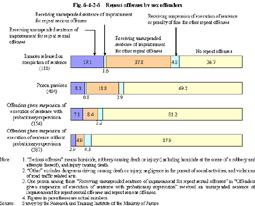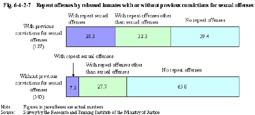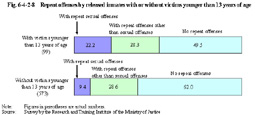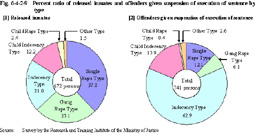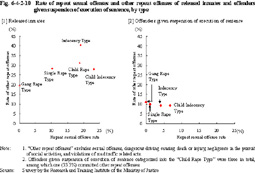| Previous Next Index Image Index Year Selection | |
|
|
2 Repeat offenses by sex offenders
We will analyze the situation of repeat offenses by sex offenders based on the results of the repeat offense survey.
(1) Survey targets
The targets of the survey were 672 sexual offense inmates who were released from penal institutions in 1999 (hereinafter referred to as "released inmates" in this Section) and 741 sex offenders who were granted suspension of execution of sentence in 2000 (hereinafter referred to as "offenders given suspension of execution of sentence" in this Section). We examined repeat offenses by such persons up to December 31, 2004. Repeat offenses of dangerous driving causing death or injury, negligence in the pursuit of social activities, and violations of road traffic related acts are excluded.
(2) Situation of repeat offenses
Fig. 6-4-2-6 shows the situation of repeat offenses by released inmates (inmates released on completion of sentence and prison parolees) and offenders given suspension of execution of sentence (offenders given suspension of execution of sentence with probationary supervision and offenders given suspension of execution of sentence without probationary supervision).
Fig. 6-4-2-6 Repeat offenses by sex offenders The repeat offense rate of released inmates was 39.9% (63.3% for inmates released on completion of sentence and 30.8% for prison parolees) and the repeat sexual offense rate was 11.3% (19.1% for inmates released on completion of sentence and 8.3% for prison parolees).The repeat offense rate of offenders given suspension of execution of sentence was 13.5% (18.8% for offenders given suspension of execution of sentence with probationary supervision and 12.1% for offenders given suspension of execution of sentence without probationary supervision) and the repeat sexual offense rate was 3.8% (7.1% for offenders given suspension of execution of sentence with probationary supervision and 2.9% for offenders given suspension of execution of sentence without probationary supervision). With regard to released inmates, Fig. 6-4-2-7 shows the situation of repeat offenses of persons with and without previous convictions for sexual offenses, and Fig. 6-4-2-8 shows the situation of repeat offenses of persons with and without victims younger than 13 years of age. Fig. 6-4-2-7 Repeat offenses by released inmates with or without previous convictions for sexual offenses Fig. 6-4-2-8 Repeat offenses by released inmates with or without victims younger than 13 years of age (3) Analysis of repeat offenses by type
We will analyze and examine the characteristics of the repeat offense survey targets based on five types we used for the analysis of the reality of sex offenders.
Fig. 6-4-2-9 shows the percent ratio of released inmates and offenders given suspension of execution of sentence by type. Fig. 6-4-2-9 Percent ratio of released inmates and offenders given suspension of execution of sentence by type Fig. 6-4-2-10 shows the repeat offense rate of released inmates and offenders given suspension of execution of sentence by type, by dividing the rate into the repeat sexual offense rate and the rate of other repeat offenses (excluding sexual offenses, dangerous driving causing death or injury, negligence in the pursuit of social activities, and violations of road traffic related acts).Fig. 6-4-2-10 Rate of repeat sexual offenses and other repeat offenses of released inmates and offenders given suspension of execution of sentence, by type |
